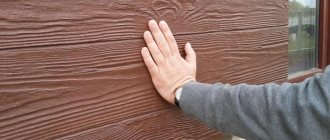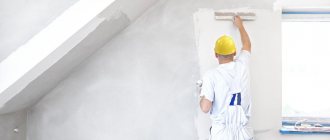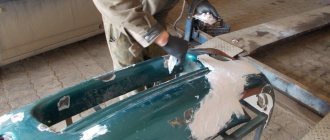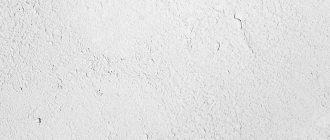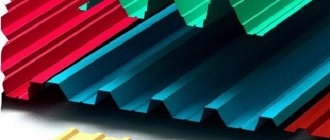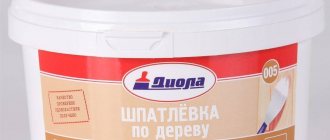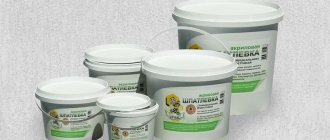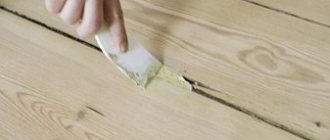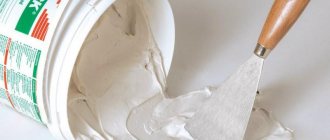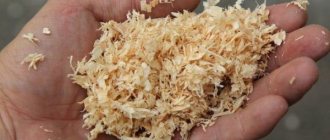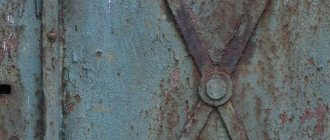MesterulManole
12988 0 4
MesterulManole October 25, 2016Specialization: many years of experience in finishing works of residential and office premises, summer houses, country cottages, etc. Hobby: cycling in all its forms
Ready-made putty and tools for its application
Greetings. In this article I will talk about what metal putty is and how it is used for its intended purpose . I hope the topic of the article will be of interest to many, since leveling metal surfaces requires the use of special materials with mandatory adherence to the technology of their application.
Types of putties
The following types of putties are most often used to repair metal surfaces:
- Two-component polyester.
- Epoxy.
- Nitro putty.
Now let's take a closer look at the features of each type of these materials.
Two-component polyester
These putties are called two-component because before use, a hardener must be added to the bulk of the mixture . It should be noted that the bulk of materials intended for working with metal are polyester. (See also the article Features of decorative putty.)
The main feature of this coating is that it practically does not shrink and can be applied in several layers, and also has good adhesion.
Note! Polyester materials cannot be applied to paint coatings, anti-corrosion primers and plastic materials.
Such mixtures are of the following types:
- Finishing or finishing – provide a smooth surface, seal cracks, pores, dents.
- Fine-grained - designed to eliminate minor defects and irregularities. They are easy to process with your own hands, in addition, they can be applied to surfaces treated with rough coatings.
- Coarse and medium grit - designed for filling large holes and dents. Can be applied directly to steel, fiberglass or old putty.
Often, polyester putties are produced reinforced with metal powders or fiberglass. The latter are used to seal through holes, irregularities and deep dents. However, such coatings are unstable to mechanical loads and vibrations. (See also the article Which putty is better to putty on drywall.)
Repairing a metal surface with a polyester mixture
Advice! If you need a heat-resistant putty for metal, you should pay attention to some polyester mixtures that have this property.
Mixtures with metal powder are resistant to vibration, but can only be used on solid surfaces.
Epoxy
Epoxy putty for metal is also two-component.
Its main advantages include the following points:
- High strength.
- Has anti-corrosion properties.
- Resistant to chemicals.
- Shrinkage after drying is very insignificant.
- Can be applied in fairly thick layers.
- It has good adhesion to any type of surface.
- Easily processed with abrasive tools.
- Durability.
- Can be used over old paint or putty. It does not require priming; simply degrease the surface.
The composition, as a rule, hardens after 6-8 hours, after which further processing can begin. Other advantages of this material include its low price.
Nitro putties
Nitro putties are one-component, ready-to-use compounds. They are quite easy to use, but they give a large shrinkage, which is up to 15 percent. Therefore, they are used to repair small scratches and irregularities. .
The layer applied at a time is approximately 0.1 millimeter, so the surface is covered with it several times. Before you putty the metal, it is advisable to use a primary primer.
The bulk of the mass of such mixtures is created by special fillers. As a rule, all kinds of neutral fibers or powders are used for these purposes, which increase the volume of the material. Most often the composition includes metal powders, fiberglass or minerals.
In the photo - a surface coated with a composition with glass fibers
Depending on the filler, the compositions are divided into:
- Fine-grained – allow you to get a smooth surface, practically without holes and pores.
- Coarse-grained - have pores, but at the same time they are stronger than fine-grained, making them more difficult to process.
- Reinforced with fiberglass or metal powder. They are the most durable material that can even be used to seal through holes in metal.
- Lightweight. Designed to fill large masses without increasing parts.
Polyester putty. In this regard, polyester putties are classified as follows:
- Universal polyester putty. It contains two main elements, as well as specialized minerals and silicone- and asbestos-free fillers as additional additives. It is distinguished by its ability to dry in a fairly short period of time. This putty is perfect for leveling surfaces made of metal, wood, concrete, aluminum, zinc, and polyester. Thanks to its unique properties, which include plasticity, strength, and minimal shrinkage, it is easily applied to the surface and perfectly hides various irregularities.
- Facing putty. It has a fine-grained structure. Just like the previous type, it takes little time to dry. Mainly used to eliminate minor irregularities, scratches, and pores. This type of finishing materials can act as a finishing layer for painting or a primer mixture. It fits well on surfaces, the main material for which is concrete, metal, wood, polyester or zinc. It is characterized by great flexibility and fillability, thanks to which the work proceeds quite easily and quickly.
- Fiberglass putty. It is based on fiberglass filler. This material is used to level out damage of varying volumes, as well as small through holes and areas damaged by rust. Shows resistance to various mechanical damage.
Scope of application of metal putties
Metal putties can be used for surfaces made of ferrous and non-ferrous metals, as well as galvanized products. Some types are also suitable for galvanized surfaces. Putties are used for the following operations:
- leveling: the composition fills dents, cracks and scratches;
- strengthening surfaces by increasing the thickness of the product;
- sealing holes;
- anti-corrosion treatment of surfaces, including those already affected by rust.
Metal putties are wear-resistant and can withstand weathering, moisture, frost and other adverse influences. They are usually applied before painting.
Metal putty is purchased for repair and protection against corrosion of metal building structures and elements: fences, railings, stairs, metal garages and gates, door hinges, etc. Such putties are also useful for processing metal pipelines.
Metal putties are in demand not only in construction. Thus, they are actively used in the repair of cars, water transport, industrial equipment, and restoration of the surface of various metal products.
Fireproof putty for the stove - purpose and application
During active use of the furnace during the first five years, a large number of cracks appear that allow carbon dioxide and carbon monoxide to pass through.
- Properties and composition
- Choice of putty
- Criterias of choice
- Top brands
- How to make fireproof putty with your own hands?
- Kiln Putty Instructions
- Conclusion
For a room, such cracks are very dangerous, since a person staying in the house for a long time can cause irreparable harm to health. Therefore, they must be sealed, and fire-resistant putty will help with this. You can also use this mixture to hide visual defects.
Polyester putties
Polyester putties are very popular today, despite the fact that their price is quite high. But the cost is compensated by the high qualities of the material.
The basis of such compositions are unsaturated polyester resins. The composition may also include various fillers: fiberglass, aluminum powder, glass microgranules.
Advantages of polyester putties:
- low shrinkage (about 0.5%), due to which the composition can be applied in several layers and without fear of cracks;
- good grip on the surface;
- strength, resistance to external influences;
- heat resistance: many compositions can withstand up to 100 degrees, and some can withstand much higher values. Thus, the high-temperature putty ROBERLO SN96 can withstand up to 250 degrees Celsius (it is usually used for car repairs);
- dry quickly.
The presence of additional components gives polyester putties special properties. Thus, compositions with fiberglass filler can be used to seal even fairly large holes in metal. The applied layer has increased strength.
“Aluminum” putty (marked Alu on the packaging) makes the surface of the product more resistant to damage, vibration and vibration. Heat-resistant primer for metal up to 300 degrees? In addition, the composition with aluminum is heat-resistant.
Polyester putties are two-component. They are sold as a set of two containers (or jars), one containing the putty base and the other containing the hardener. These two components must be thoroughly mixed together immediately before use and used within a few minutes.
Using polyester putties, metal surfaces of varying degrees of damage are leveled. With skillful work, the mixture lays out in an even layer. For a better result, you can first use a starting (“coarse”) polyester putty, and then a finishing putty (with a fine fraction) for finishing for painting.
There are also universal formulations.
Pentaphthalic putty
Pentaphthalic varnish acts as a binding component in such putties. Heat-resistant primer for metal in cans? The composition also includes fillers, pigments, organic solvent, etc.
Such putties are usually inexpensive.
Pentaphthalic putties have a two-component composition (base plus hardener). The degree of shrinkage is quite high - 3-5%, so the scope of application of the composition is limited. It is often used to eliminate minor surface defects on ferrous or primed metal surfaces.
Usually the mixture is applied in several thin layers up to 0.5 mm each, the total application thickness is up to 2 mm.
The popular pentaphthalic putty PF-002 takes quite a long time to dry - at a temperature of 20 degrees it will take up to a day. But the composition adheres well to primers and is not fluid. When applied correctly, it forms a smooth layer that is easy to sand.
The top of the putty can be coated with pentaphthalic, oil, alkyd-urethane and other paints.
Epoxy putty
Such putties consist of a solution of epoxy resins and a hardener. They are very popular because in most qualities they are not much inferior to their polyester analogues, and are cheaper than them.
Main characteristics of polyester putties:
- shrinkage rate - only 0.1%;
- strength;
- high adhesion to any type of surface;
- long drying: the composition hardens in 20 minutes, but it takes a day to dry completely.
Epoxy putty is quite fluid. Therefore, to treat vertical surfaces, it is recommended to mix chalk, kaolin or talc into it.
Nitrocellulose putties
They are sold in the form of a ready-made mixture that can be puttied on immediately after opening the container.
Nitro putty has the highest degree of shrinkage - up to 15%. Therefore, it is applied in a very thin layer and, accordingly, is only suitable for repairing minor defects (chips, scratches).
The advantages include fairly quick drying - about two hours. In addition, nitro putties have good resistance to high temperatures.
Additional Information:
TERMO – epoxy putty Termo putty is a two-component epoxy putty for powder paints, designed for repairing minor damage and unevenness of metal surfaces. It is characterized by a short curing period, similar to epoxies, and a very high level of mechanical strength. How does putty for metal differ from putty for plastic? It also has excellent adhesion and high temperature resistance.
The curing process can take place either outdoors or in an oven.
For example, such a leveling mixture dries quickly upon contact with air, and therefore, after opening the package, it is better to use it immediately and not leave it for later. In addition, nitro putty, despite fast drying, is characterized by the most intense shrinkage (up to 15%).
“TROTON Spec High Temp is a high-quality two-component cold-curing polyester putty with excellent resistance to high temperatures up to 200°C. The electrically conductive composition is intended primarily for surface treatment in preparation for powder coating. The product has elasticity and very high adhesion to various substrates after appropriate preparation.
It is to prevent such conflict situations and to be able to track the entire technological chain to identify violations, Audrey LLC
6 years ago I purchased my own set of control equipment
that allows me to evaluate the quality of work and operation of the painting area
.
Types of putties
There are putties for metal, which are divided into one- and two-component. Manufacturers produce mixtures of different compositions:
- polyester;
- epoxy;
- nitro putty;
- pentaphthalic.
Each composition has its own specific characteristics and features when applied to the surface. If you have a choice when buying a putty for metal products, you need to pay attention to its properties; a high-quality putty should have the following:
- short drying time;
- high adhesion to the coating;
- high degree of ductility, even after drying;
- ease of application and maximum surface leveling;
- minimum shrinkage after completion of work;
- compatibility with varnishes or coloring components.
Which metal putty is better, everyone decides for themselves when purchasing.
Polyester
Two-component putties are polyester-based compounds to which a hardener must be added before use. The advantages of this type of putty are that it:
- does not shrink;
- has a high degree of adhesion to the surface;
- heat resistant;
- easy to apply.
On the construction market, polyester putties are presented in the following versions:
- Finishing or finishing. They provide sealing of cracks, dents and scratches, at the same time maximally leveling the coating.
- Fine-grained composition. This option is used to eliminate small cracks and irregularities.
- Medium-grained and coarse-grained. Such mixtures can be used to fill large holes and dents; they can be applied either to a clean surface or to one previously treated with putty.
Choice of putty
In specialized construction stores, the choice of putty for stoves is simply huge, so purchasing the necessary option does not present any difficulties.
Many buyers focus on the cost of the mixture, as it plays a role. If you are purchasing putty for a master, then it is worth checking which company he prefers to work with, since different mixtures “lay” on the surface differently.
Criterias of choice
The main selection criteria are:
- Putty color;
- Permissible operating temperature;
- Fat content of the clay used;
- Mixture ratio.
These parameters play a role for specialists who professionally lay stoves. If you are faced with this task for the first time, it is better to check with a consultant about the best option.
Top brands
The best brands today are recognized as:
- Bergauf Bau Termo - Germany, an excellent German manufacturer, the average price of a 25 kg bag of mixture is 500 rubles.
- REAL is a Russian manufacturer that is distinguished by its high price and quality. The cost of a bag of material is about 800 rubles.
- PLITONOT – Russia, a bag of the mixture costs no more than 500 rubles.
DIY metal putty
Before you start puttingtying a metal surface with your own hands, you need to decide on the type of mixture that will be suitable in this case. However, among the variety of putty materials for metal, the most popular is a mixture with an epoxy composition.
After acquiring the necessary material, a step-by-step process occurs:
- The first step is to prepare the coating well, remove rust and dirt, degrease and prime it. If you use an epoxy mixture, you can do without a primer.
- A certain amount of putty that will be needed for the job must be mixed with a hardener. After thoroughly mixing the base until smooth, you can begin puttying.
- Using a thin spatula, apply the mixture to scratches, dents or existing holes in the metal. The excess is carefully removed with the same spatula so that there are no flaws.
- When the putty solution hardens on the surface, it must be sanded with sandpaper soaked in water. The result is a smooth and even surface, ready for powder painting in the desired color.
How to make fireproof putty with your own hands?
The chemical composition of the putty is quite simple, so if the issue of price and quality is important to you, then you can create your own putty from scrap materials. For these purposes, ordinary clay is used, which can be found in any region of the country.
It is recommended to use the factory version, as it undergoes thorough processing and purification from impurities. Otherwise, the fire-resistant properties may be reduced, which will lead to an unpleasant odor in the house.
The process of making putty is simple and straightforward - it consists of several successive steps:
- Mix the clay with water, leave it to soak for a day, and then stir it further with construction equipment.
- The clay is rubbed through a fine mesh with a cell diameter of no more than two millimeters. This step removes impurities and large particles.
- The sand is also wiped in the same way as the previous step. The proportion of adding sand and clay is two to one.
- The mixture is thoroughly mixed until a homogeneous putty is obtained.
Additional recommendations
Metal coating experts recommend the following:
- Before starting the work process, you should definitely read the instructions from the manufacturer, first of all, pay attention to the timing of application and the purpose of the putty for a specific coating.
- It is better to prepare the putty mixture in batches so that you have time to use the required volume before it hardens.
- The surface that requires treatment must be clean and free of grease. You can use a universal degreaser for this.
- The hardener and base must be mixed well according to the proportions, otherwise defects may occur during the work process.
- The mixture is applied in thin layers, if there are more than 3 layers, you need to give each layer time to dry. The polyester mixture is dried at a temperature no higher than +75 degrees, otherwise it will crack.
If you need to choose a high-quality putty mixture for working with metal parts, pay attention to its purpose and properties specified by the manufacturer.
